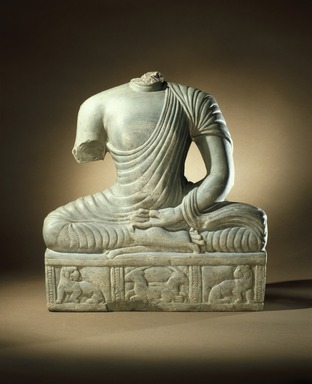
Medium: Green limestone
Geograhical Locations:
Dates:late 3rd century
Dimensions: 16 1/2 × 15 × 4 1/8 in., 59 lb. (41.9 × 38.1 × 10.5 cm, 26.76kg)
Collections:
Museum Location: Asian Galleries, Southwest, 2nd floor
Exhibitions:
Accession Number: 86.227.24
Image: 86.227.24_SL1.jpg,
Catalogue Description: Image of the Buddha Shakyamuni seated in meditation. The figure's head and lower right arm are void. The image is carved in the round, but its overall form is flattened, suggesting that it was carved from a shallow slab of stone. The Buddha wears a monastic robe draped over one shoulder and there is a wheel incised on his foot (representing the dharmachakra, the Buddhist emblem for righteousness). Beneath the Buddha figure is a throne platform with images of lions at either end and a pair of deer at the center. The deer suggest that the image represents the Buddha giving his first sermon, at the site of a deer park in Sarnath, India. If this is the case, then the right hand may have originally been raised in a gesture of teaching, or (more common for a raised right hand) the gesture of reassurance. The green limestone and smooth, rounded forms of the sculpture recall carvings found at the southern Indian site of Nagarjunakonda, which was an active Buddhist center under the patronage of the female members of the Ikshvaku royal family.